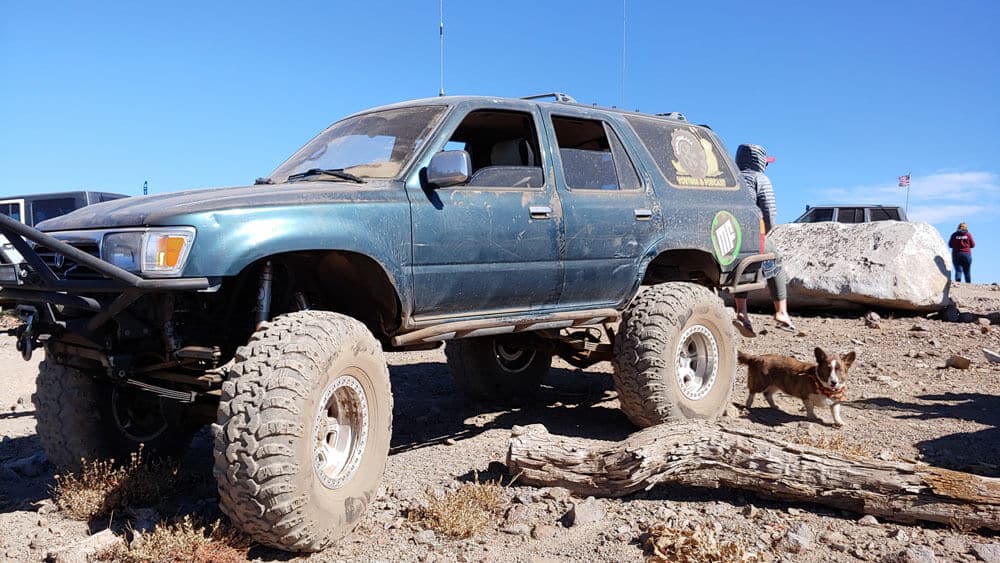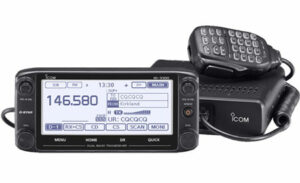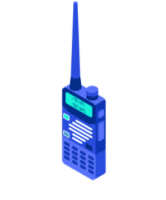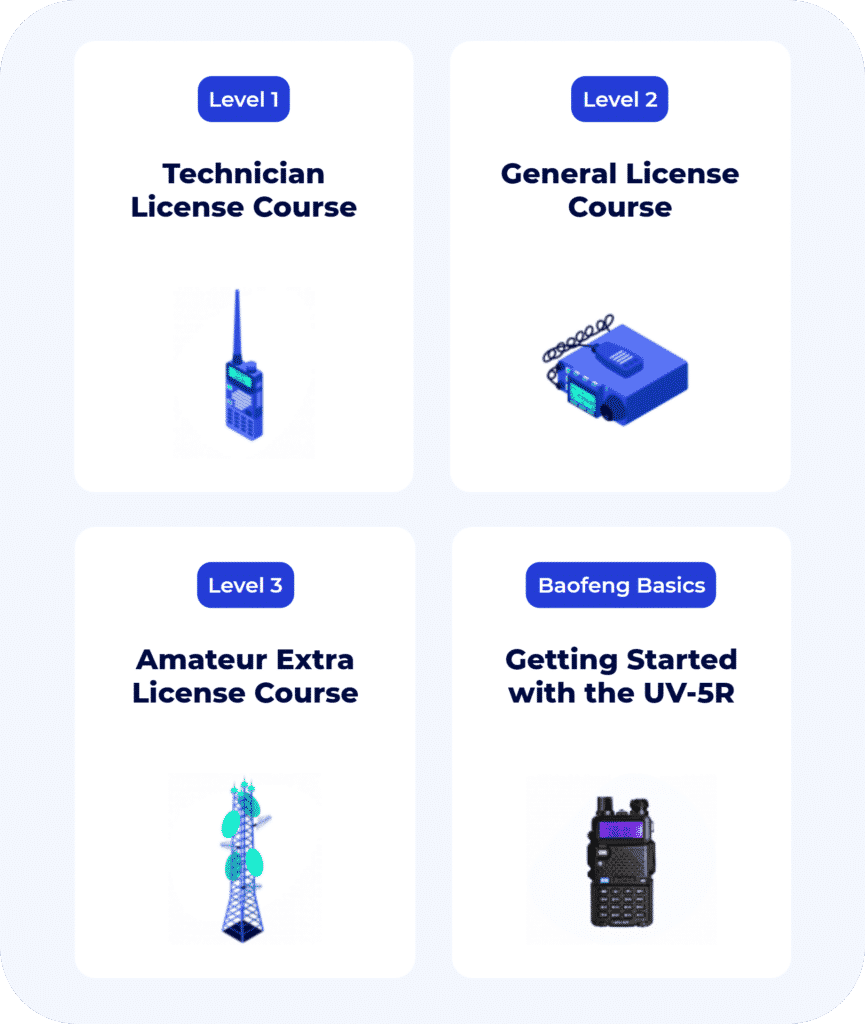Interested in ham radio as an offroader? In this guide, we’ll explore the benefits of getting your ham radio license as an offroading enthusiast, and how it can improve your overall experience on the trails.
We’ll talk about the benefits of ham radio and compare it to other communication methods. We’ll also help you get your license and help set up your offroad ham radio system in your vehicle (car or truck).
So, buckle up and get ready to learn how ham radio can take your offroading adventures to the next level!
What is Ham Radio?
Amateur radio, also known as ham radio, is a popular hobby and service that allows licensed users to communicate with others using radio frequencies. These frequencies are allocated by the Federal Communications Commission (FCC) in the United States.
Offroading can be a thrilling and adventurous hobby, but it’s essential to have reliable communication, especially when you’re in remote locations or tackling challenging terrain. That’s where the flexibility of ham radio comes in. By getting your amateur radio license, you can improve your experience off-grid with multiple communications options.
The Benefits of Ham Radio for Offroading
1. Better communication range
One of the most significant advantages of ham radio over other communication options like CB (Citizens Band) radio and FRS/GMRS (Family Radio Service/General Mobile Radio Service) is its superior communication range.
Comparing Ham Radio with CB and FRS/GMRS
CB radios typically have a range of about 3 to 5 miles, while FRS/GMRS radios can reach up to 5 to 25 miles, depending on the terrain and equipment. In comparison, ham radio can achieve much greater distances, even hundreds or thousands of miles, depending on the frequency, power output, and atmospheric conditions.
This extended range can be a lifesaver when you’re offroading in remote areas where cell phone coverage is non-existent or unreliable.
We’ve found that ham radio is much more reliable. This is because of the greater power available with ham radio, as well as multiple frequency bands that can be chosen. A broad network of repeaters also helps relay communications.
We’re told a group was able to stay in contact with each other using ham radio even when separated by more than 30 miles, this would have been impossible with CB or FRS/GMRS radios.
2. Stay prepared for emergencies
Ham radio can help you prepare for and handle emergencies much better. One of its main purposes is to provide communication when other services can’t.
- You can call for help:
Ham radio allows you to reach other radio operators, emergency services, and amateur radio emergency networks, increasing your chances of getting assistance in remote offroading locations. Because ham radio is not dependent on the status of the cell networks, you can reach others when there is no cell service. - You can monitor the weather and natural disasters:
You can access weather and emergency frequencies to stay informed about real-time weather conditions and updates on natural disasters, helping you avoid hazards and plan your route accordingly. Ham radio frequencies are adjacent to the National Weather Service’s NOAA Weather Radio frequencies, so most ham radios can receive these alerts. In addition, many storm chasers are hams, and you can hear their traffic during a weather event.
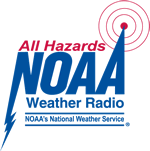
Read more about ham radio in emergency communications.
3. Better Technical Advantages
You also get many technical advantages when using amateur radio over other forms of communication, such as:
- Improved signal clarity and audio quality: Traditional CB uses 8 KHz bandwidth while 2 Meter ham radio FM uses 15 KHz.
- Access to a wider range of frequencies and bands: US CB is limited to 27 MHz frequencies and GMRS is around 465 MHz. Ham radio has frequencies in those 2 ranges plus at 6 Meters (50 MHz) and 2 Meters (144 MHz).
- The ability to use higher power output for increased range and reliability: CB is limited to 5 watts. GMRS is 50 watts maximum. Ham radio operators can use up to 1,500 watts on all the bands listed above with the proper license.
- Digital modes and messaging capabilities, enabling text-based communication and data transmission: APRS is a popular tool for sending and receiving position information over ham radio and many handhelds have this built in.
![]()
These features make ham radios a more versatile and powerful communication tool, as it ensures reliable communication during your overland adventures.
Best Ham Radio Equipment for Overlanding
When it comes to setting up a ham radio system for offroading, choosing the right equipment is essential. You can get more reliable communication, and improved safety.
Selecting the right ham radio equipment
Radio type and power output:
Choose a mobile ham radio unit designed for offroading, with rugged construction, water and dust resistance, and user-friendly interfaces. Consider the power output based on your communication range requirements.
Antenna selection and placement:
Select a durable dual-band or multi-band antenna suitable for off-road use. Opt for NMO mounts that provide a secure connection and easy antenna replacement. Place the antenna in a location with minimal obstructions for optimal performance. Higher is better. Read more about antenna options.
Power supply and battery management:
Ensure your vehicle’s electrical system is well-maintained and consider a deep-cycle battery for a reliable power source. Use power distribution blocks and fuses to protect your equipment and simplify cable management. Some hams use portable LiFEPo batteries to handle their radio needs while in the field because of their lightweight per amount of energy stored.
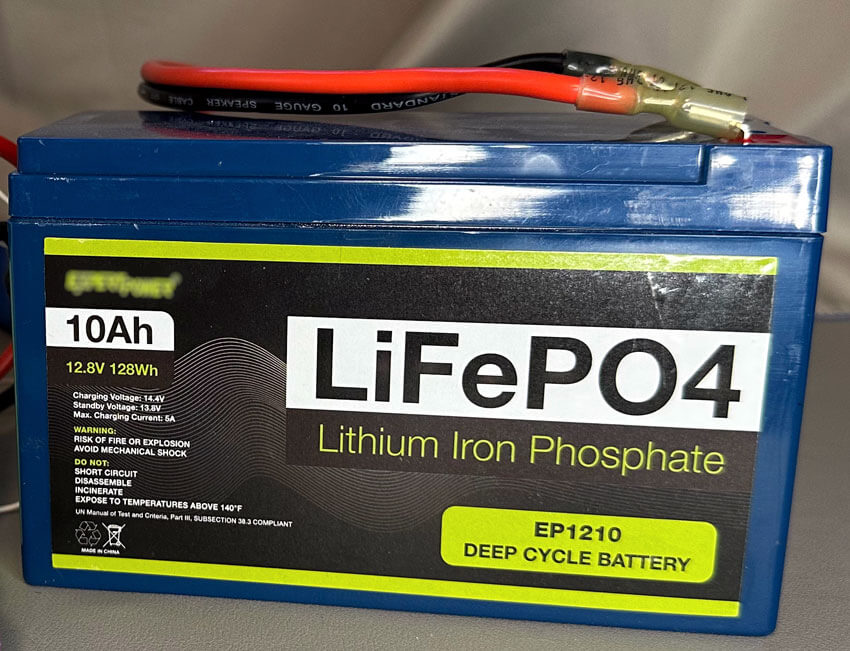
Best Mobile Ham Radios for Offroading
Mobile ham radio units are designed to be installed in vehicles and offer features that are great for offroaders. Look for models with rugged construction, water and dust resistance, and user-friendly interfaces.
Here are the 5 best mobile ham radios for offroading:
1. Yaesu FTM-400XDR
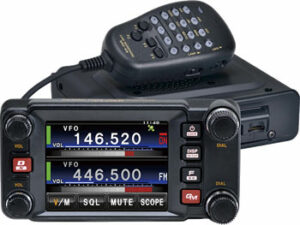
This dual-band radio offers a rugged design, a user-friendly touchscreen interface, and supports both analog and digital C4FM modes. Its integrated GPS and APRS (Automatic Packet Reporting System) functionality make it ideal for offroading by allowing you to share your location with others.
2. Icom IC-2730A
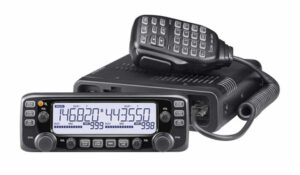
The Icom IC-2730A is a dual-band radio with a large, easy-to-read display and a rugged design that can withstand harsh offroading conditions. It has a user-friendly interface and supports various mounting options, making it easy to install in your offroad vehicle.
3. Icom ID-5100A
The Icom ID-5100A is a dual-band radio with a large detached display that includes a GPS receiver. In addition to compass and direction information onboard, it covers the 2 Meter and 70 CM radio bands. It’s an analog FM and D-STAR digital radio with wide band receiving to cover bands like aviation.
4. AnyTone AT-778UV

This compact, budget-friendly dual-band radio offers excellent performance and a variety of features suitable for offroading. It has a durable design, a clear and bright display, and supports both narrow and wide FM modes. The radio is also compatible with CHIRP programming software, allowing for easy customization and channel management.
5. TYT MD-9600
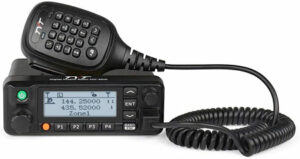
The TYT MD-9600 is a dual-band radio that supports both analog FM and digital DMR modes. It features a rugged design and a high-resolution color display for easy operation. The radio’s GPS and APRS functionality, along with its compatibility with various digital modes like group and private calls, make it an excellent choice for offroading communication and navigation.
Each of these mobile ham radios offers unique features and advantages that are great for offroaders. By choosing one of these radios, you’ll benefit from reliable communication, improved safety, and better enjoy your offroading experience.
You can also check out our top 5 handheld radios!
Ham Radio is Versatile!
Ham radio offers a high level of versatility and is very customizable, allowing you to get the right communication system for your offroading.
Here’s what we mean by ‘versatility’:
Repeaters and linking systems
- Repeaters: Devices that receive and retransmit signals, extending the range of your communication. Repeaters can be critical in offroading situations where obstacles or terrain might limit direct communication.
- Linking systems: Technologies like EchoLink and IRLP enable you to connect to other ham radio operators over the internet, providing even greater reach and connectivity options.
Digital modes and messaging
- Digital modes: Various digital communication methods, such as D-STAR, System Fusion, and DMR, offer improved signal quality, error correction, and additional features like text messaging and data transmission.
- Messaging: Ham radio systems can support text-based communication and data transfer, which can be especially useful when voice communication is not possible or practical. Check out Winlink where you can send emails using ham radio!
Integration with GPS and mapping tools
- GPS integration: Many ham radio systems have onboard GPS receivers or can interface with GPS devices, allowing you to share your location with other radio operators and receive location data from others.
- Mapping tools: Software like APRS (Automatic Packet Reporting System) can be used to plot the location data from GPS-enabled ham radios on maps, providing real-time situational awareness during your offroading adventures.
Go portable or dual band
- Handhelds: When you get where you are going, you may want to explore on foot. A wide variety of handhelds will keep you connected to your “base” vehicle while exploring the area.
- Dual Band: Traveling with a large group. Many radios can handle two frequencies at one time. Keep one for overall communication while having a second frequency for your foot travelers or organize by vehicle types. Or just monitor the weather radio for alerts.
How to Setup Ham Radio in Your Car or Truck
Here is a step-by-step guide to installing an offroad ham radio system in your car or truck.
Step 1: Gather the necessary equipment
- Mobile ham radio unit (see list above)
- Dual-band or multi-band antenna
- NMO mount for antenna
- Coaxial cable
- Deep-cycle battery (optional)
- Power distribution block and fuses
- Mounting brackets or custom mounts for radio and antenna
- Cable organizers or conduits
Step 2: Select the mounting location for the radio
- Choose a location that is easily accessible and within reach while driving
- Ensure the location has adequate ventilation to prevent overheating
- Use custom mounts or brackets to secure the radio unit in place
Step 3: Install the antenna
- Identify a suitable location on your vehicle for the antenna, ideally with minimal obstructions for optimal performance
- Install the NMO mount according to the manufacturer’s instructions
- Attach the antenna to the mount and ensure it is secure
Step 4: Connect the radio to the antenna
- Run the coaxial cable from the radio unit to the antenna, avoiding sharp bends and potential damage from moving parts or hot surfaces
- Use cable organizers or conduits to manage the cable and protect it from damage
- Connect the coaxial cable to the radio unit and the antenna, ensuring a tight and secure connection
Step 5: Connect the radio to the power source
- Locate your vehicle’s battery or fuse box, and plan the route for your power cables
- Install a power distribution block and fuses near the radio, following the manufacturer’s guidelines for fuse ratings
- Connect the power cables from the radio to the power distribution block, ensuring proper polarity and a secure connection
- Run the power cables from the distribution block to the vehicle’s battery or fuse box, using cable organizers or conduits for protection and neatness
- DON’T plan on using a “cigarette lighter” style power connector. The wiring to the plug may not be up to par for the amount of current your radio will draw.
- If using a deep-cycle battery, connect it to the vehicle’s electrical system according to the battery manufacturer’s instructions
Step 6: Ground the radio
- Identify a suitable grounding point on your vehicle’s chassis or frame, ensuring good metal-to-metal contact
- Attach a grounding cable from the radio unit to the grounding point, using a ring terminal or similar connector
- Ensure the grounding connection is secure and free of corrosion or paint
Step 7: Program the radio
- Power on the radio and familiarize yourself with the controls and menu system
- Program your radio with local repeater frequencies, emergency channels, and preferred simplex frequencies
- Organize channels for easy access during offroading, grouping them by purpose or region as desired
- Consult the radio’s manual for any additional programming options or features, such as APRS or digital modes
Step 8: Test your system
- Turn on the radio and ensure all controls, displays, and features are functioning correctly
- Perform a test transmission on a simplex frequency or repeater to confirm proper operation, and check your antenna’s SWR for optimal performance
- If possible, have a fellow ham radio operator or a local ham radio club member verify your signal and audio quality
Step 9: Secure and tidy up the installation
- Double-check all connections and mounting points for security and stability
- Use cable organizers or conduits to neatly bundle and route wiring, preventing damage or interference with other vehicle systems
- Ensure the installation is both functional and aesthetically pleasing, balancing performance with the appearance of your vehicle
Great! You have now successfully installed a ham radio system in your vehicle! Enjoy your radio communications and stay safe.
With the right equipment and proper installation, you can enjoy your offroad adventures, and make sure you’re safe in cases of emergencies.
Conclusion
Having a ham radio license for offroading is great and has many benefits, such as improved communication range, better preparation for emergencies, access to a supportive community, and technical advantages that are not available with other communication systems.
By getting your ham radio license and installing a reliable amateur radio system in your vehicle, you can significantly improve your off-road experiences and stay connected with others who share your passion for the same adventure.
We highly encourage offroaders to take the steps needed to get their ham radio license, at least to prepare themselves for an emergency. You will also gain valuable knowledge and experience that can help you elsewhere. Don’t wait – start your journey toward becoming a licensed ham radio operator today!

